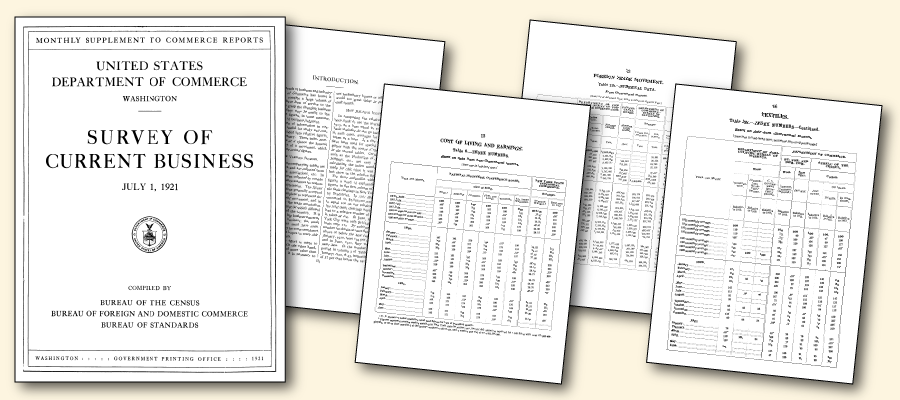Looking Back at the First Issue of the Survey of Current Business
The Survey of Current Business has been a respected and comprehensive source of data on the health of the American economy for almost a century. Each month, for almost 100 years, from periods of prosperity to depression, from wars to peacetimes—and during 17 presidencies—countless economists, statisticians, accountants, theoreticians, and others have reported accurate, timely, and innovative statistics that are relied upon by investors, policymakers, and consumers, not just in the United States, but around the globe. To mark this milestone, the Bureau of Economic Analysis (BEA) is observing a 12-month centennial celebration leading up to the anniversary of the first issue of the Survey, published on July 1, 1921.
The first issue leads with the statement “To visualize the current trends of business and industry monthly, the Department of Commerce has found it necessary to condense and compile a large volume of information.” The statistics reported come from private sector sources and government departments and include banking and finance, price index numbers, earnings and employment, retail, foreign trade, and specific sectors of the economy.
Today’s Survey continues to cover these aspects of the economy. Some things have changed: The statistics in the first issue were provided as absolute values and index numbers to report on what are called “relative figures.“ The 100th volume reports on estimates from modern macroeconomic concepts in the framework of national, international, regional, and industry accounts.

From the introduction in the July 1921 Survey of Current Business: “To visualize the current trends of business and industry monthly, the Department of Commerce has found it necessary to condense and compile a large volume of information. These facts have been of service to the Department in its attempt to grasp the changing business conditions. It is believed they may be useful to the business public and that the figures, in some measure, will assist in the enlargement of business judgment. To concentrate such a mass of information in convenient form and to make it useful for study and comparison, the data have been coded into relative figures, or index numbers, where necessary. These index numbers enable the reader to see at a glance the general upward or downward tendency of a movement, which can not so easily be grasped from actual figures.”
From the beginning, the Survey recognized the importance of timeliness. The introduction states “. . . it is realized that timeliness is often of more value than extreme accuracy. In certain cases it is necessary to use preliminary figures or advance estimates . . .” BEA continues to advance the timeliness of our statistics and their reporting via our online databases as well as the Survey.
Please join us as we take a look back at the first issue of BEA’s flagship journal of record—the Survey of Current Business, “Volume 1, Number 1.”